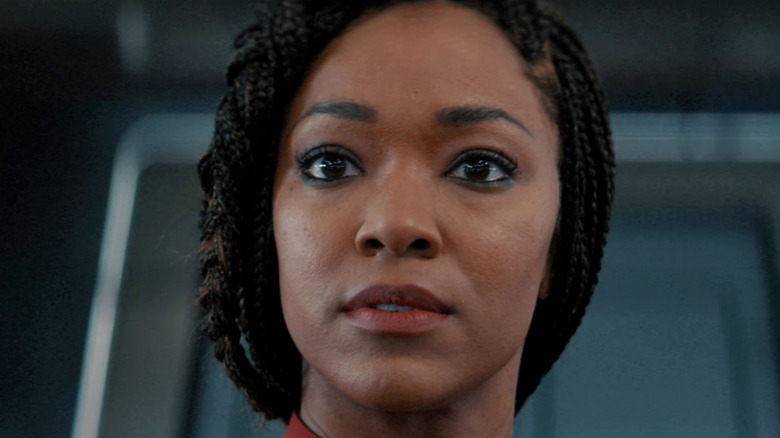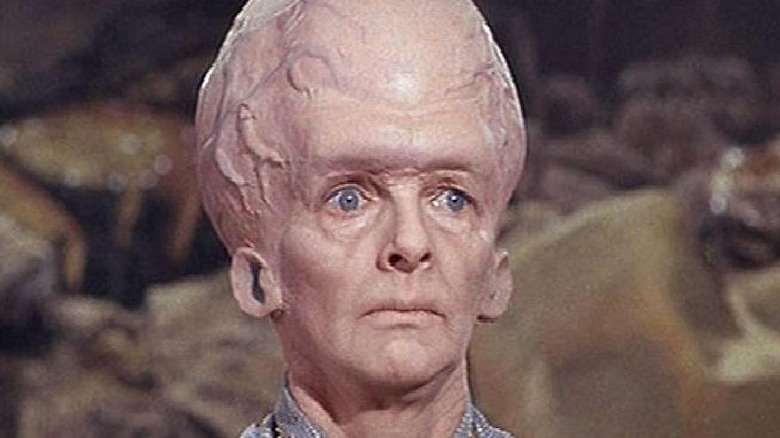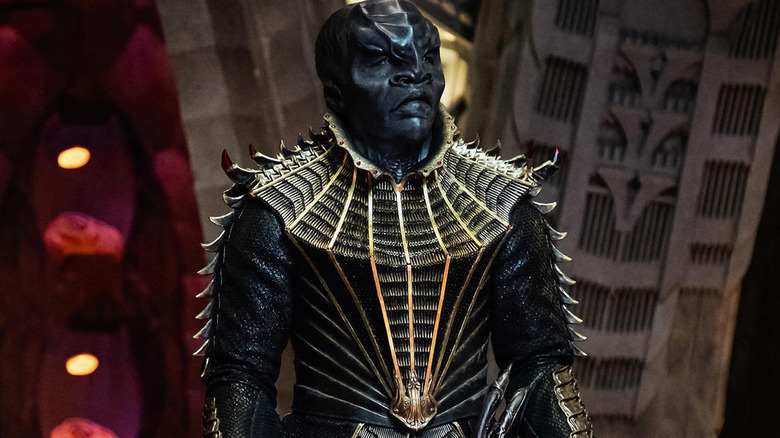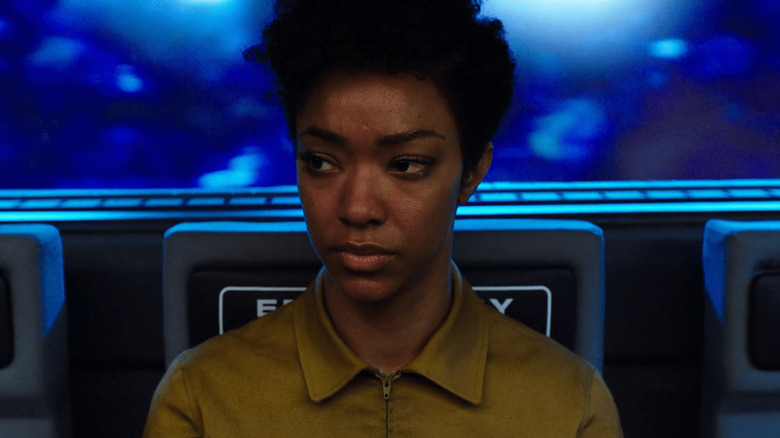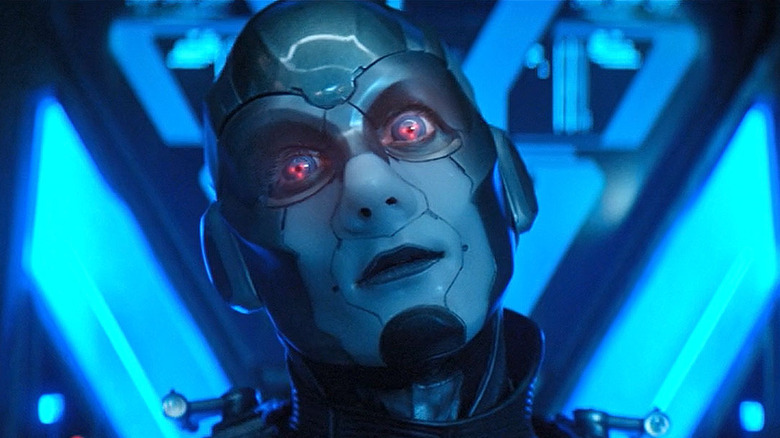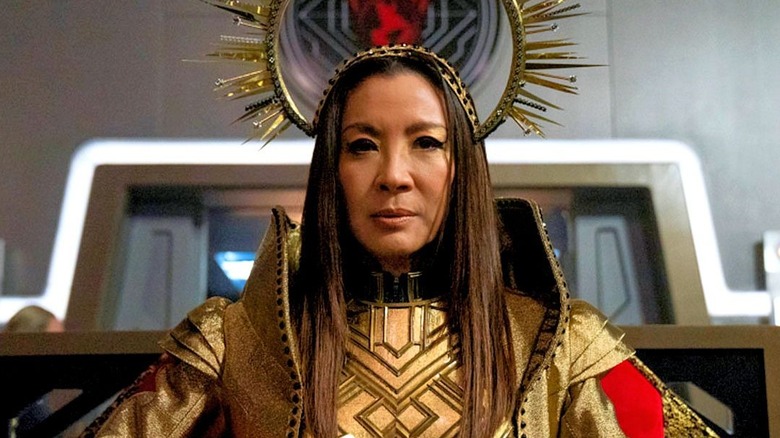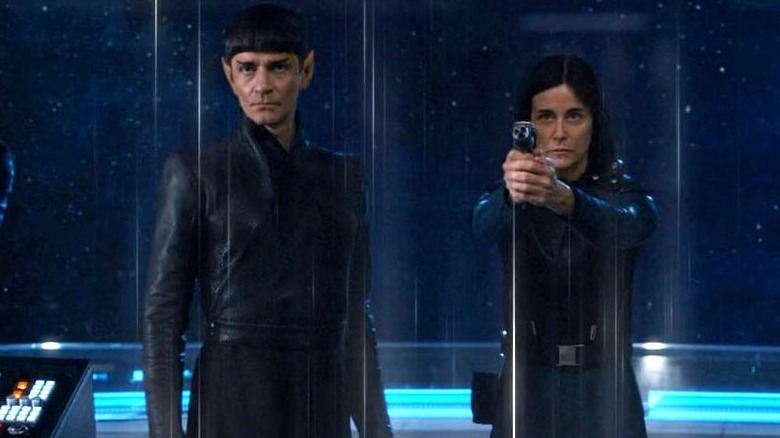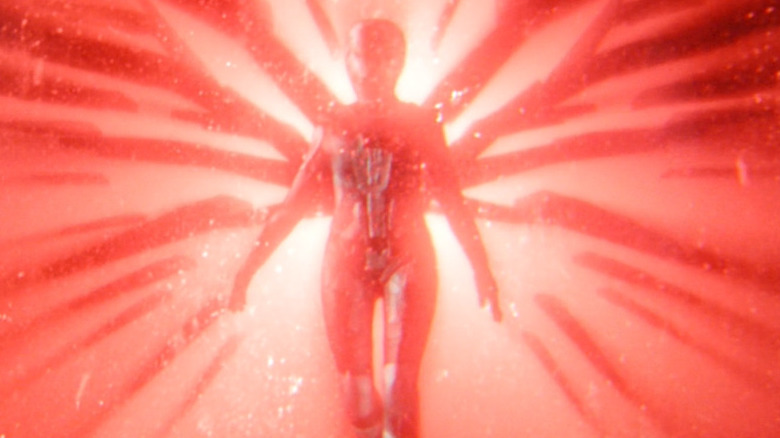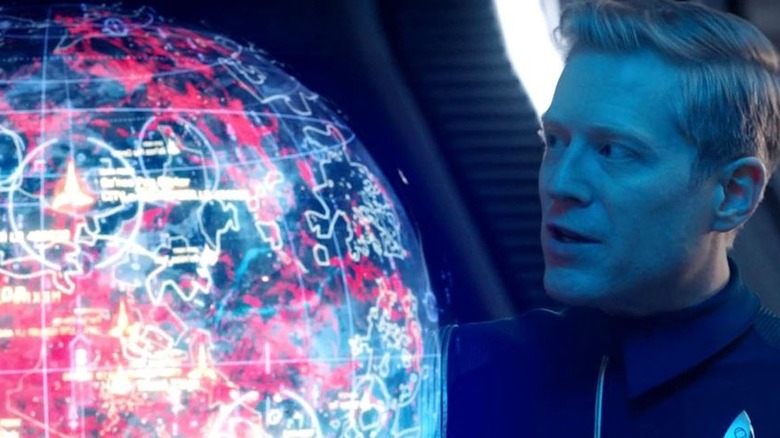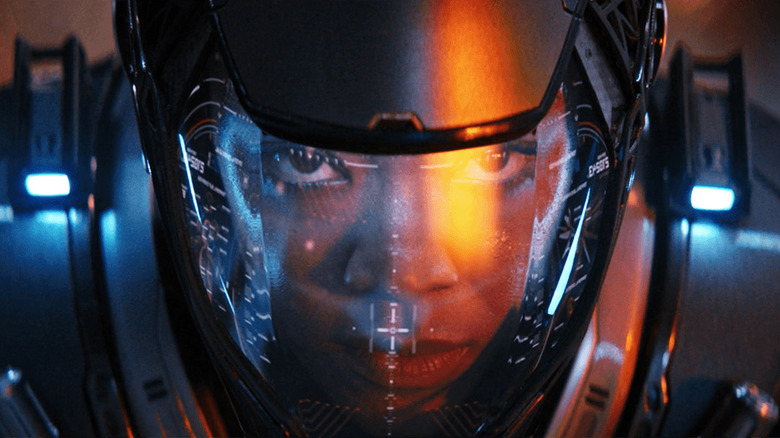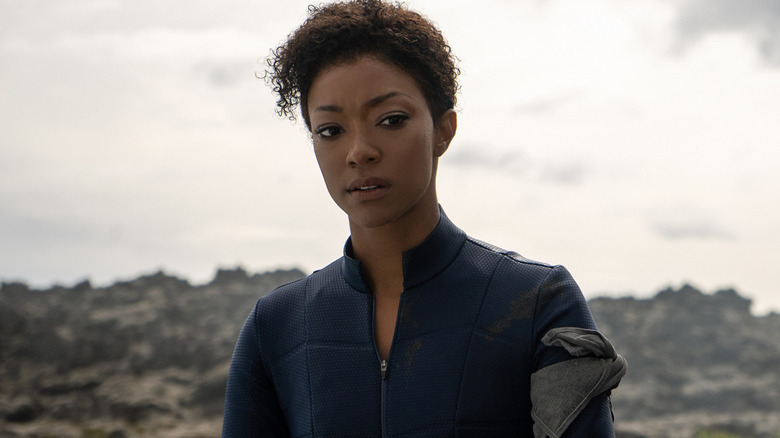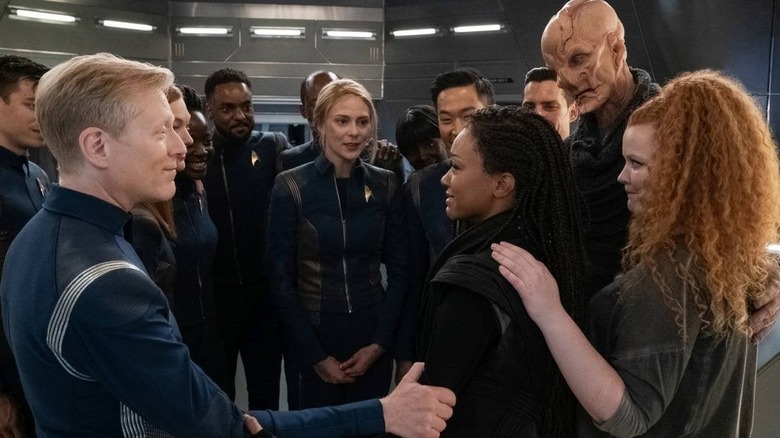The Entire Star Trek: Discovery Timeline Explained
For a series ostensibly about exploring the galaxy and meeting new lifeforms in the hopes of sharing knowledge and resources, there sure is a lot of time travel in "Star Trek." It's been present from the very beginning, as even Kirk and crew visited the past multiple times. Two of those adventures resulted in the iconic episode "The City on the Edge of Forever" and "Star Trek 4: The Adventure Home."
Modern "Star Trek" adventures have embraced this aspect of the universe, as time travel was also the direct cause of the Kelvin Timeline featured in the 2009 "Star Trek" film and its sequels. When the Romulan Nero traveled back in time and destroyed the USS Kelvin, killing James Kirk's father, he accidentally contributed to the creation of a new universe running parallel to the prime timeline. Ultimately, time travel has become every bit as important to "Star Trek" as exploration.
"Star Trek: Discovery" is no exception to this. Initially a prequel series set ten years before the original series, it soon became a sequel set further into the future than any other "Star Trek" installment. Time travel tends to muddy the narrative progression of a story, so we will be looking at where "Star Trek: Discovery" started to shed some light on where it ended up. Here is the entire "Star Trek: Discovery" timeline explained.
A visit to Talos
"Star Trek: Discovery" is set ten years before what is now referred to as "Star Trek: The Original Series." However, one episode of "The Original Series" actually occurs before "Discovery." In many ways, it is the beginning of the entire "Star Trek" franchise. While most viewers back in the late '60s probably remember it as the story told in the exciting two-parter "The Menagerie," which reuses the footage captured for the original "Star Trek" pilot called "The Cage."
We have to begin here because these events play a crucial role in "Star Trek: Discovery" Season 2. "The Cage" sees the Enterprise crew, led by Captain Christopher Pike, visiting Talos IV, encountering a strange alien race. These are the Talosians, telepaths who experience life by manipulating beings they keep in their menagerie. By forcing Captain Pike to endure multiple illusions of their creations, they hope to understand love, anger, fear, excitement, and other emotions they forfeited by choosing to further develop their mental abilities.
Years later, after Captain Pike temporarily assumes command of the USS Discovery, he is forced to revisit Talos IV to cure Spock of his current mental disorder. Not only is it a chance to save Spock's life, but it also allows Pike to seek out closure regarding his past experiences on the planet.
The Battle at the Binary Stars
"Star Trek: Discovery" officially begins with a huge two-part story called "The Vulcan Hello" and "The Battle at the Binary Stars." This is where we meet the star of the show, Commander Michael Burnham, the first officer of the USS Shenzhou. While most "Star Trek" shows tend to be ensemble pieces, "Discovery" belongs to Burnham and it is her arc that we follow.
This opening episode sees Starfleet encountering Klingons for the first time in about a century. An extremist group of Klingons led by the xenophobic T'Kuvma engaged in a devastating battle with the USS Shenzhou after an altercation with Burnham resulted in the death of one of their own. This opening battle becomes a war between the Federation and the Klingons, the effects of which are still being felt during "The Original Series" and the six original "Star Trek" movies.
Following this battle, Michael Burnham is stripped of her rank and sentenced to life in prison — which leads to the true beginning of the show.
Six months later
Following Michael's sentencing, the show jumps ahead six months. While being transferred to a new prison, there's an emergency and the Discovery arrives to save her. While on the ship she meets its captain, a dark and elusive man named Gabriel Lorca, and its crew. She also reunites with her old friend from the Shenzhou, Commander Saru. Healing their relationship following her mutiny is a major part of the first two seasons of "Star Trek: Discovery."
Lorca believes that Michael's knowledge and experience could be of some use to them on the Discovery, so he invites her to unofficially join them as a specialist. The reasons behind Lorca's decision to go out of his way to save her, and why he wants her working with him on the Discovery, is another major element to the first season. His character comes off as a little strange right away, as Starfleet captains tend to be fairly approachable and diplomatic. However, Lorca is intimidating, conniving, and a little too adept at war to fit the typical captain archetype.
Taking Control
To correctly understand the timeline of "Star Trek: Discovery," we next need to dive into some events that are revealed during Season 2 but take place in Season 1.
Section 31 is the secret Black Ops division of the United Federation of Planets. They operate in the shadows, carrying out missions the Federation doesn't want to be made public. They feature heavily in "Star Trek: Discovery" and its second season. Following the events of "The Battle at the Binary Stars," Section 31 starts using a threat assessment artificial intelligence called Control in the hopes of preventing wars.
The idea is the Federation would give Control information regarding potential threats, and Control would then provide suggestions on how to proceed. As often happens in science fiction when artificial intelligence is involved, things go haywire when Control decides it no longer needs human beings to implement its suggestions. Instead, it assumes "control" of human beings to enact its agenda. This leads to the massive time jump the USS Discovery would take into the future during the end of Season 2.
Into the Mirror Universe
The USS Discovery has an experimental new system called a spore drive. It allows the Discovery to travel along a microscopic network spread throughout the universe, effectively making instant travel possible. It's an incredibly complex system, one that Forbes notes was inspired by a real-life mycologist, which can be used to break the barriers between realities.
The idea is proposed to astromycologist Commander Paul Stamets by Captain Gabriel Lorca. Stamets is considering leaving Starfleet, but Lorca convinces him to stay on to try one final experiment to see if it truly is possible to visit alternate realities. The experiment works, and the entire crew of the USS Discovery is transported into the classic evil dimension of the "Star Trek" universe — the Mirror Universe.
In the "Star Trek" Mirror Universe the heroes are villains and the villains are heroes, and it is soon revealed that this is where Lorca is from. He arrived in the prime timeline, took over the original Gabriel Lorca's life, and orchestrated events to unite with Michael Burnham — who was his lover in the mirror universe — and use the spore drive to return to his universe and overthrow Emperor Georgiou.
While the time the crew spends in the mirror universe might seem brief, it turns out that nine months pass during that time.
Nine months later
When Gabriel Lorca dies in the mirror universe, the crew of the USS Discovery returns to their native universe — but they've brought the emperor with them.
One of Michael Burnham's defining character traits is parental issues. She lost her human parents at a very young age. She was then adopted by the Vulcan Sarek and his human wife, Amanda. They raised her on Vulcan with their son Spock, effectively making her Spock's human step-sister.
Although she tried to live like a Vulcan, her human emotions were far too powerful. As a result, when she joined Starfleet and was assigned to serve on the USS Shenzhou, she gravitated to its human captain Phillipa Georgiou, seeing her as a maternal figure. Tragically, Georgiou died in the Battle of the Binary Stars, and the guilt of her loss has tortured Burnham ever since. Upon arriving in the mirror universe and finding another Georgiou, she can't help but try and bring her back to the prime timeline, hoping to correct her biggest regret.
Back in the prime timeline, they discover that nine months have passed and the war has not been going well. Discovery is boarded by Sarek and Admiral Cornwell, who informs the recently-returned crew that the Klingons have almost won the war.
The mystery of the Red Angel
By the end of Season One, the Klingon War is over, and there is an uneasy peace between the two sides. However, the crew of the Discovery doesn't have long to reflect on these events, as they soon encounter the Enterprise and are boarded by Captain Christopher Pike. Pike has been directed to temporarily assume command of the Discovery to research red burst anomalies that have been popping up all over the galaxy.
The red bursts are caused by an entity referred to as the Red Angel. The identity of this entity and the reasons for its actions are complex but intimately related to Michael. It turns out that there are two Red Angels — one is Michael Burnham's mother, Gabrielle, and the other is Michael herself. The form of the angel is actually a suit capable of traveling through time developed by Michael's parents as a project for Section 31.
At some point, Gabrielle decides to use the suit to escape an attack from Klingons but winds up in the distant future. She sees that the AI system Control has taken over the galaxy, so she uses her suit to jump around in time in the hopes of preventing Control from evolving and spreading across the galaxy. Michael then uses the suit to send signals that appear as red bursts for the crew of the Discovery to follow, defeat Control, and travel to the future.
The all-knowing Sphere
Season 2 of "Star Trek: Discovery" is full of big, wild ideas that could serve as the basis for a film or an entire series. The first, of course, is the threat of Control. The second is the Red Angel. The third is a sentient, planet-sized lifeform called the Sphere.
This Sphere has spent hundreds of thousands of years exploring the galaxy, collecting information and experiences. It has existed for such a long time that it is now dying. With such a wealth of knowledge and experience, it doesn't want to be forgotten, so it transfers its memory to the Discovery's computers.
As wonderful a find as this is, it is also incredibly dangerous. When Airiam, a cybernetic member of the Discovery crew, is infected by a future version of Control, she is directed to transfer all the sphere data on artificial intelligence to the current form of Control. With that information, Control will be able to gain full sentience and take over the galaxy — just as seen in Spock's vision from the Red Angel.
Defeating Control
For any "Star Trek" fans upset that "Star Trek: Discovery" takes place 10 years before "The Original Series" but the technology is significantly more advanced — or that Spock never mentioned having a human step-sister — their fears were partially quelled when the ship made the jump ahead almost one thousand years.
By the end of Season 2, Control was defeated, the mystery of the Red Angel was solved, and the need to get the sphere data to a safer time period arose. With the data merging to Discovery's computers, the decision was made not to try and delete the data but take it into the future. Using the Red Angel suit, Michael Burnham drags the USS Discovery into a time in a future not yet explored by the "Star Trek" franchise.
Once Discovery is gone, the Federation decides to clear the ship's existence from all Starfleet records and never speak of it, the crew, or its mission again. Thus, Michael Burnham is never mentioned, nor is the Discovery or its experimental spore drive.
The future of Starfleet and the Federation
The jump to the future is successful, but Michael arrives there alone. Since she was towing the ship, not riding in it, the trip was different for her. Immediately upon arriving, she rams into a ship piloted by Cleveland Booker before being pulled in by a nearby planet's gravity, regaining control of the Red Angel suit only seconds before splattering on its surface.
At first, she is panicked that Discovery won't answer her call but is soon thrilled by the knowledge that there is life on this planet. She eventually meets Cleveland Booker and discovers that the Federation barely exists anymore. The reason for its diminished size and influence was something called the Burn. In the 31st century, nearly every warp core installed in Federation ships exploded, wiping out swaths of life and nearly destroying the Federation. Exactly what caused this "burn" is the central mystery of Season 3.
One year later
In this new world, where dilithium is more precious than ever, Michael travels the galaxy, trading it for goods and services. She spends an entire year recording her experiences and searching for any sign of the Discovery. Finally, her search efforts pay off, and she is reunited with her crew. In a completely new headspace, Michael isn't sure about serving on the Discovery any longer. True, she earned back her respect and rank but is she is more interested in solving the mystery of the Burn and restoring the Federation rather than limiting herself to a single ship.
By the end of Season 3, the mystery surrounding the Burn is solved, the Federation is in the early stages of reconnecting with its lost members, and Michael joins the crew of the Discovery again. This time, however, she isn't a specialist or a first officer — she is the captain.
Season 4 is still set in the 32nd century and Michael is now known as Captain Michael Burnham. Her arc mirrors the real-life arc of the show. She started as a first officer who lost everything and worked her way back to a command position, while "Star Trek: Discovery" began life as a prequel with a dubious connection to canon and became a sequel that takes the franchise to brand new heights.
